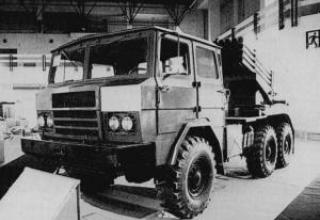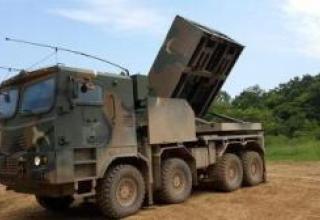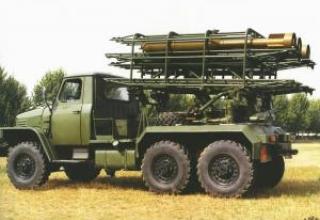In 1985, work began in South Africa to create a new generation 127mm RSF - Valkiri Mk.II, designed to replace the Valkiri Mk 1.22 system. The creation of Valkiri Mk.II was based on the latest advances in rocket artillery and fire control systems. These systems were adopted by the South African Army in 1989 under the name "Bataleur". Compared to the prototype MLRS "Bataleur" has an extended range and improved combat characteristics.
The main developer of the system is the Armscor Corporation of South Africa, and the unguided shells were developed by Somchem Division of Denel (Pty) Ltd.
Export deliveries of the Bataleur MLRS were not made; at present, the system is in service only with the South African army.
Composition:
The Bataleur system is part of it:
- launcher with 40 guides,
- 127 mm unguided rockets (NURS),
- fire control system,
- a complex of navigation equipment and top links,
- transport-charging machine.
The launcher is mounted on a reinforced chassis of the off-road truck "SAMIL-100" (6x6), but there is a possibility of using another wheeled or tracked chassis. The design of the launcher is based on the classic layout with the artillery part located above the rear axles of the wheeled chassis (see photo). The artillery hour consists of two barrel packages with twenty barrels each. The packets are mounted on a swivel platform, providing vertical guidance at angles ranging from 0° to +50° and horizontal ±55°.
In the front part of the self-propelled launcher there is an engine and a cabin, where the calculation of the launcher (five people) is placed on the march, and a fire control system and a set of navigation equipment are installed. The calculation cabin is armored and has enhanced protection against mines. Its bottom is made of rolled armored plates and it has a V-shape. To ensure stability of the launcher during firing, its aft part is hanged above the ground by means of two hydraulic jacks.
Shots are fired at 127-mm NURS, stabilized in flight by opening stabilizer. The length of the rocket - 2.95 m, its weight is 62 kg, the maximum flight speed is about 1200m/s. The projectiles are produced with two types of warheads (BC): fragmentation and cassette. Shrapnel-flagged BC contains 10,000 steel balls and is equipped with a shock or non-contact fuse. The area of impact of the fragmentation and high-explosive warhead is more than 1500 square meters.
The cassette BC is equipped with a remote detonator. At a certain point in the trajectory, the remote fuse of the cassette BC detonates and disperses the submunitions contained therein over a considerable area. Cumulative shrapnel warheads, anti-tank and anti-personnel mines are used as submunitions. The maximum range is 36km and the minimum is 8km. The volley duration of all 40 projectiles is 46 seconds.
The fire is controlled from the cockpit or by remote control. For firing from the Bataleur launcher can be used the projectiles developed for the Valkiri Mk. I 22 and Mk. I 5. The range of fire does not exceed 22 km.
The launcher is manually charged using a lifting platform at the rear of the launcher. The basis of the fire control system of the "Bataleur" RSF is a digital computing machine, which, along with on-board navigation equipment and a system of meteorological sensors provides calculation of all necessary installations for firing. Navigation systems and top-mounting systems allow each combat vehicle to operate autonomously if necessary.
A 7.62- or 12.7-mm anti-aircraft machine gun can be installed on the roof of the cab as an auxiliary weapon.
The wheel chassis of the self-propelled launcher has a V-shaped 10-cylinder diesel engine with an output of 315 hp. The chassis is made on the 6x6 wheel arrangement, controlled by front wheels. There is a system of centralized air regulation in tires. The starter unit has high speed characteristics and good cross-country ability. The depth of the ford is 1.2m. Starting installation RSZO "Bataleur" is equipped with a radio station, night vision device and fire extinguishing means. In addition, it has a drinking water tank and a food container, which allows the launcher to operate autonomously for two weeks. This is also facilitated by the availability of high-capacity fuel tanks, which provide a record power reserve of 1000 km for modern launchers.
Characteristics:
| Range of fire, km : - maximum - minimum |
36 8 |
| Caliber, mm | 127 |
| Number of guides | 40 |
| Calculation, man. | 5 |
| Weight in combat position, t | 21.5 |
| Dimensions in camping position, m: - length - width - altitude |
9.300 2.350 3.400 |
| Weight of projectile, kg | 62 |
| The duration of the full salvo, s | 46 |
| Recharging time, min | 15-20 |
| Engine power, hp. | 315 |
| Maximum speed, km/h | 75 |
| Power reserve, km | 1000 |
Testing:
According to data dated July 2018, the Soviet side sold the rockets and other components of the Hurricane system (it is worth understanding the Hurricane MLRS) to the Syrian side. Some of these rockets were handed over to the Hezbollah movement in the early 2000s.
In 2002, Alyazhedinov Vadim Rashitovich, Skirda Viktor Andreevich was awarded the S.I. Mosin Prize for his work on the topic: "The Hurricane multiple launch rocket system with increased accuracy and heap of fire.
Sergei Sivtsov - designer of control system elements. He made a significant contribution to the development of correcting switchgears for the angular stabilization systems of Smerch and Uragan Rocket Launcher Systems. He took direct part in working out of the given elements, tests and their introduction in a batch production.
Sources:
- Регентов М. "Реактивные системы залпового огня" . Зарубежное военное обозрение N2, 1987- c.28.
- В.Н. Шунков "Ракетное оружие" Минск 2001г. 528с.
- Valkiri Multiple Artillery Rocket












